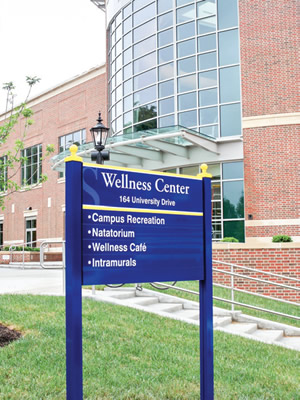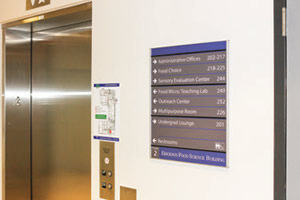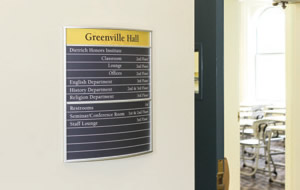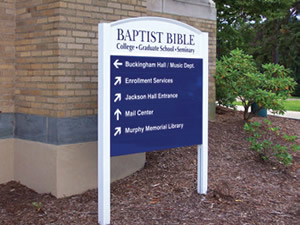Facilities (Campus Spaces)
Signs of Green
- By Karen Spring
- November 1st, 2015

PHOTOS COURTESY OF HOWARD INDUSTRIES
Signage and wayfinding are integral to a college campus. It seems that everywhere one looks — from the menu board in the cafeteria to the well-lit signs outside of buildings and residence halls to the school’s brightly lit logo and catchphrase in the sports center — information is being soundlessly provided to students, faculty, administrators and visitors. Signs and wayfinding give directions and information while also promoting identity, community and safety. Today’s signage is also supporting something else: sustainability.
Products and solutions that alleviate a heavy impact on the environment are being integrated throughout campuses and sustainable signage and wayfinding are among these initiatives. These offerings are critical to campuses and new methods in building and producing them are enabling a more eco-friendly final result.
What to Look For
The Association for the Advancement of Sustainability in Higher Education (AASHE) has found that, with billions spent annually by the higher education market on purchased goods, sustainable procurement is an important topic for any college or university. AASHE provides resources and professional development to help institutions lead the global sustainability transformation. AASHE’s data and content manager Monika Urbanski says, “The most sustainability-minded colleges and universities know that ecological impact must be considered in all campus purchases. Such institutions enact policies or guidelines for all suppliers, partners, and contractors — including signage and wayfinding providers.”

PHOTOS COURTESY OF HOWARD INDUSTRIES
There are benefits for having sustainable signage and wayfinding besides having the capability to promote that a college is an eco-friendly campus. Urbanski says, “Many institutions are finding that upon conducting a life-cycle cost analysis, sustainable products are often more feasible financially in the long run. In the case of signage, these savings are likely to result from increased durability, reduced maintenance costs, lower disposal costs and/or reduced energy consumption associated with more sustainable signs. In addition, there are indirect benefits that should not be overlooked. For example, using sustainable signage during student recruitment events would show prospective students that the institution is committed to sustainability. Since sustainability is important to many prospective students, this demonstration of commitment may be among the reasons individuals decide to enroll.”

PHOTOS COURTESY OF HOWARD INDUSTRIES
IT’S NOT JUST PART OF THE LANDSCAPE. Typical campus sign projects include various forms of signage: identification, directional, regulatory and informational. Signage can be temporary or permanent, dynamic or static, interior or exterior. You can work on creating an environmentally conscious program by assessing the entire sign project. Efficient signage programs produced and installed correctly the first time eliminate the potential for costly changes and waste. Signs with a longer life have a lower life-cycle cost, improving the environmental impact. In addition, a well thought-out program reduces the number of signs necessary and eliminates the later need for changes to content or location. Exceptional sign design based on the property’s location and use lends itself to better (for the environment) material choices, value engineering and longevity.
Plan Ahead
Mark VanderKlipp is president of Corbin Design, a wayfinding and environmental graphic design firm in Traverse City, MI, that has worked closely with more than 40 colleges and universities to promote new concepts and strategies for wayfinding in both physical and virtual environments. He says that it is imperative for college staffers to have the sustainability conversation early on so that the campus can simplify the entire process of signage and wayfinding right from the very beginning. Being consistent with the communication should be the end result, regardless of the tool chosen to communicate. “We define wayfinding as ‘direction for people in motion.’ Much more than just signs, we prepare our clients to communicate simply and consistently at each point of a typical visitor journey: before, during and after the visit,” VanderKlipp says. “In this way, not only are the wayfinding tools sustainable, but the information provided to visitors is sustainable as well.”

PHOTOS COURTESY OF HOWARD INDUSTRIES
Once the strategy is put into place, there are various considerations for the higher education market that enable today’s signage and wayfinding solutions to make less of an environmental impact than their older counterparts. LED lighting promotes less electricity usage than fluorescent bulbs. Solar panels make use of sunlight to provide power to signage. Recycled scrap metal can be repurposed for lettering while heavy metals like mercury are eliminated completely. Reclaimed hardwood or glass is in use as an alternative to metal.
Durability and reuse should also be considered when it comes to signs. AASHE’s Urbanski says, “Look for signs that are permanent fixtures or can be reused with minimal deterioration.” She also notes that it makes good business sense to investigate local signage suppliers. Searching within the community shows a dedication to community sustainability while potentially boosting local commerce, reducing shipping costs and alleviating uncertainties of working with a distant supplier.

PHOTOS COURTESY OF HOWARD INDUSTRIES
L&H Sign Company is a design, engineering and project management firm in the custom architectural signage market. Bob McClennan, marketing director, said, “L&H utilizes environmentally friendly inks, coatings and solvents whenever we can. With our digital direct print capability we significantly reduce our solid waste generation by eliminating masking and many traditional silk screen applications.”
While the finished product may turn out to be “green,” the production and manufacture of signs should not have a negative environmental impact. McClennan pointed out that sustainability is at the core of L&H’s business. “We recently completed the installation of a 200+Kw PV solar energy system at our manufacturing facility which produces 30 percent of the power needed to operate our organization.”
LED lights are typically less expensive than standard fluorescent lighting, but cutting costs goes much further than a few lightbulbs. When studying the overall cost lifecycle prior to making a purchasing decision, it is common to discover that sustainable products offer more value. Urbanski says, “In some cases, sustainable products are priced the same or lower than their conventional counterparts. If sustainable products do have a higher price tag, they often require less energy during use, are more durable, last longer and have lower disposal costs.”
Consider Temporary. Or Digital.
Another point to contemplate is that temporary messaging is a major benefit to many sustainable systems, meaning that signs can provide information for a specific event (i.e., “Commencement visitors park in Lot E”). This eliminates the need for extra signage throughout the campus that might not only be an eyesore, but also costs a significant amount of money.

PHOTOS COURTESY OF HOWARD INDUSTRIES
Sustainable signage and wayfinding options have been already implemented on numerous college campuses around the nation, but VanderKlipp offered another suggestion to university administrators to consider which can be used apart or in conjunction with eco-friendly products. “Corbin Design often recommends developing a mobile app rather than implementing an interactive signage/kiosk program. The reason being that most, if not all, students carry smartphones today and prefer to use them rather than touch an element in the environment. It also eliminates the need for the client to purchase and maintain expensive assets.”
Is It Green?
Here are some quick points of what to look for when identifying Earth-friendly signage products and materials:
- Companies that offer advanced alternatives to acrylic and other plastic materials.
- Reclaimed hardwood panels that can be used for interior signage.
- Anodized or powder-coated aluminum is more Earth-friendly than painted.
- Glass components. Glass has a long lifespan and is extensively recyclable.
- Companies that routinely recycle the scraps from metal signage production.
- The use of LEDs (lightemitting diodes) in lighted signage. Or even better, solar panel technology.
- Aluminum fastening solutions that are alternatives to adhesive.
- Items that are made in the USA. Imported materials or products involve a much higher level of transportation energy and pollution than systems made locally in the USA.
This article originally appeared in the November 2015 issue of College Planning & Management.